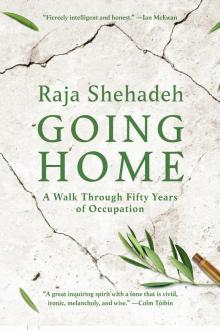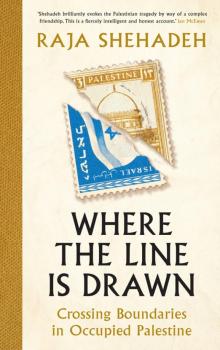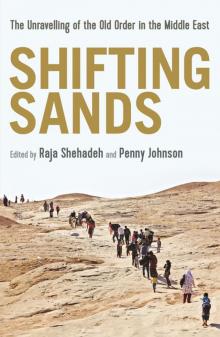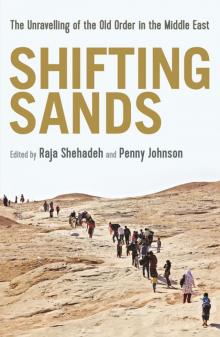- Home
- Raja Shehadeh
Going Home
Going Home Read online
Praise for Raja Shehadeh
Going Home
“Going Home cements the author’s reputation as the best-known Palestinian writing in English.”
—Ian Black, The Guardian
“Going Home is about searching for the meaning of ‘home’ when living in a city under occupation…. In this book, the bonds that bind Palestinians to the land are exposed. Personal and political, human and geographical histories are beautifully intertwined and preserved.”
—Claire Kohda Hazelton, The Spectator
“Luminously clear-sighted…. By turns lyrical, witty and shrewd, Shehadeh is an excellent walking companion.”
—Matt Rowland Hill, Prospect
“An insightful, illuminating book”
—Paddy Kehoe, RTÉ
Where the Line Is Drawn
“No one else writes about Palestinian life under military occupation with such stubborn humanity, melancholy, and fragile grace…. One feels the loss in every paragraph Shehadeh writes, but also the inescapable beauty that remains, which both softens and deepens the rage.”
—Ben Ehrenreich, The Guardian
“Writing has allowed Shehadeh to continue crossing into these territories, even as they become increasingly off-limits to him. His books are maps, painstakingly pieced together, of regions lost to senseless division, to bad choices, and to lies.”
—Ursula Lindsey, The Nation
“Remarkable and hopeful … a deeply honest and intense memoir.”
—Gal Beckerman, The New York Times Book Review
“Shehadeh describes with courage and grace the internal struggle to remain fair.”
—The New Yorker
“A beautifully impressionistic exploration of shared cultural understanding despite the narrowing of borders.”
—Kirkus Reviews
“Shehadeh’s incisive, lyrical memoir cuts to the core of a complex cultural identity.”
—Financial Times
“The question of how and if friendships can survive across political divides is a resonant one, and I can think of no one better than Raja Shehadeh to treat it with the wisdom, toughness and humanity that it deserves.”
—Kamila Shamsie
“Raja Shehadeh’s Where the Line Is Drawn is a courageous and timely meditation on the fragility of friendship in dark times, illuminating how affiliation and love—without pretence or concealment, in defiance of occupation and estrangement—can have a profound political power. I hope many people will read and dwell on this unforgettable book.”
—Madeleine Thien
“While I was in Ramallah, I met the Palestinian writer Raja Shehadeh, whose work I did not previously know. His books—including Strangers in the House and When the Birds Stopped Singing—were a discovery: he is a great inquiring spirit with a tone that is vivid, ironic, melancholy, and wise.”
—Colm Tóibín
“In the dark agony of the Palestine-Israel conflict, Raja Shehadeh offers a rare gift: a lucid, honest, unsparing voice. His humanity and wisdom are invaluable. Where the Line Is Drawn powerfully records many testing aspects of Shehadeh’s life under Israeli occupation, but at its heart is his long-lived friendship with a fellow intellectual and seeker, Jewish and Israeli. In their bond lies reason for hope…. It’s a beautiful book.”
—Claire Messud
“The weight of oppression, as Raja Shehadeh calls it, bears down on every page of this delicate, thoughtful memoir of Palestinian life under Israeli occupation.”
—Fatima Bhutto
Palestinian Walks
“A work of passionate polemic, journeying, history, and autobiography, this highly original consideration of the Palestinian-Israeli issue is structured around a series of vigorous, attentive hikes through the occupied territories…. Ranks with Sari Nusseibeh’s memoir, Once Upon a Country.”
—The New Yorker
“Few Palestinians have opened their minds and their hearts with such frankness.”
—The New York Times
“This beautiful book is not just a guide to the Palestinian present; it is an Israeli album of what is taking place in a faraway land: Palestine.”
—Haaretz
“Raja Shehadeh’s Palestinian Walks provides a rare historical insight into the tragic changes taking place in Palestine.”
—Jimmy Carter
“A thoughtful meditation on Palestine, the land and the peoples who claim it.”
—Mahmood Mamdani
“This constantly surprising book modestly describes walking along certain paths which have touched the lived lives of two millennia…. His confessions often encounter a perennial wisdom, and what he is talking about and walking across is one of the nodal points of the world’s present crisis. I strongly suggest you walk with him.”
—John Berger
“This exquisitely written book records a sensitive Palestinian writer’s love for the landscape of his country, over which he has hiked for many years. It reflects not only the intense beauty of that landscape, but also some of the terrible dangers that threaten it and its occupants.”
—Rashid Khalidi
GOING HOME
ALSO BY RAJA SHEHADEH
Where the Line Is Drawn
Language of War, Language of Peace
Shifting Sands (ed., with Penny Johnson)
Occupation Diaries
A Rift in Time
Palestinian Walks
When the Birds Stopped Singing
Strangers in the House
GOING HOME
A Walk Through Fifty Years of Occupation
RAJA SHEHADEH
To Ingmar Bergman, whose film Wild Strawberries was an inspiration for this book
Contents
A Note to the Reader
Chapter One
Chapter Two
Chapter Three
Chapter Four
Chapter Five
Chapter Six
Chapter Seven
Chapter Eight
Chapter Nine
Chapter Ten
Chapter Eleven
Chapter Twelve
Acknowledgements
About the Author
Perhaps home is not a place but simply an irrevocable condition.
James Baldwin, Giovanni’s Room
A Note to the Reader
Palestinian Walks, published in 2007, is my account of walking in the Palestinian hills and reflecting on my work and life under occupation. The walks described there took place over a twenty-seven-year period. In this book I describe a walk that I took in the course of one day – the fiftieth anniversary of the occupation – in Ramallah, the city of my birth, trying to come to terms with the political defeats, frustrations and failures that I have witnessed over the years of occupation and resistance, as well as the changes in the city where I live. I also reflect on ageing as I visit and remember the places, people and events in my life. All this, to be able to arrive home and, in the words of Derek Walcott, look in the mirror, greet the face reflected and ‘smile at the other’s welcome’.
One
It must already be eight, I think, as I listen to the national anthem blasting out of St George’s School near my house in Ramallah. I am standing at the bathroom sink, manoeuvring the shaving blade around the deep folds in my face that have formed over the last few years. Next I comb the remaining strands of hair – still black – left on my balding head with my old brush. My onceabundant hair seems to have made its way south to my nose. There, bursting from my nostrils, I can see plenty that need clipping. How furious my father used to be when I borrowed his scissors to cut my newly emerging moustache and failed to put them back where he could find them. How could I have known then that he needed them for this older man’s purpose? As I
bring the scissors up to my nose, I examine the brown liver spots on my hands and notice that there are more of them on my temples. I wonder how long they’ve been there. Next I study the worryingly persistent red sun patch on my hand. Had I been closer to my father as he was getting on in years, I could have learned about these changes that our bodies go through as they age and been better prepared for what was to come.
After finishing my grooming I look in the mirror again. It’s all there in front of me: the bags under my eyes, the furrowed forehead, the corners of my mouth that used to be mobile but have now descended into a permanently sad expression.
Disappointment is written all over my face, expressing the real experiences and pains I have struggled through. I no longer have that silly smirk, that effacing, distant and unreal expression I wore most of the time. The face I see before me has been broken down and reassembled. It’s the confirmation of my holding fast, of not escaping or avoiding, of being baptised by fire. It expresses what I have felt and tells all without hiding anything. But things are better this way.
I try to convince myself that I’m as old as my face, which is not at all how I feel. Mine is already the face of an older man, sombre and serious, with thin lips and wrinkles that bring my expression so much closer to that of my father. My ears, which were always large, seem to have increased in size. My black eyes, with long eyelashes, are no longer radiant. It used to be that my whole being spoke through my sparkling eyes. Now the look is inward. I have aged with the years and with the occupation. Today, 5 June 2017, marks its fiftieth anniversary.
With every year I come to resemble my father more and more. I first became aware of our striking likeness a few years back, during a particularly tense time. I remember entering the barber shop where I have had my hair cut since I was five and where my father had also been a customer. Looking in the mirror as I entered, I was struck by what I saw: mine was the face of an anxious man holding himself together, wearing a fur karakul hat, the same hat my father used to wear, and a thick Harris tweed jacket with wide shoulder pads to add bulk. Yet inside this heavy garment I was small. And of course I thought of my father. When he was getting on he would have a similar look, holding himself awkwardly, thinking of himself as a younger man and straining to achieve the look, but with the tension showing regardless.
As my father advanced in years he seemed to gain energy and act more youthful. My mother often wondered where he got this energy from and suspected it was the large number of vitamin pills he was taking, if they were indeed vitamins. I thought then that this was a premonition of how I would look in later life, not occasionally but permanently, old and uncomfortable, yet straining to look happy – an assumed air of wellbeing that would deceive no one.
These days thoughts of my father are with me more often. For a long time, as I was growing up, he was like a mystery that I wanted to explore. The ailments of his ageing body and his mood swings were never discussed, perhaps because he was too proud or too anxious about growing old, so I did not know how he dealt with them. His sacrosanct law office was another mystery. I almost held my breath when I visited. His politics, his relationship with my mother, his death – all remain unresolved in my mind. But perhaps most mysterious of all was his life in Jaffa, which I wanted to emulate but couldn’t, much as I tried when I lived in Beirut and London. Jaffa, the metropolis, remains the place of my imaginings where he lived his fantasy life by the sea, in a prosperous and vibrant city. It will always have that special resonance for me, but it’s here in Ramallah where I find my parents, myself and my life scattered around in the various houses in which I’ve lived and written my books.
Every morning when I look in the mirror a serious face stares back. I try to remember that the face I have imprinted on my mind is not the face others see. I know I have another side to me, but who else would know it from looking at me? Where and when did these markers of age appear? How much manipulation and control do we have over how we look? Does our face always betray us? Is the relaxed face of a child – that time of our life when we seem to live most in the present – the real face, the real mirror of who we are? Perhaps there is little I can do to conceal anything. They say we get the face we deserve, but is that really true? It strikes me now that each memoir I’ve written is but another interpretation of my life. So maybe the way my face has matured is just another sort of memoir, one that is imprinted and that I am not in control of; maybe this one is the most honest.
After the Oslo Accords were signed between Israel and the PLO in the mid-1990s my dentist told me that I was grinding my teeth and putting pressure on my gums. And so I was. Perhaps this was distorting my face. Are those who undergo Botox treatment removing the markers of ageing, returning their face to its original true expression, or are they committing a further distortion?
As I get dressed I flex my fingers to check they’re still pliable. In 2004, rushing to a session at the International Court of Justice in The Hague on the legality of the wall that Israel was building, I stumbled on the stairs and broke my little finger. The doctor who treated me then said it was likely to become arthritic. I’m pleased to find that it is still not painful.
Now I can hear the second bell from the nearby school, summoning students to their classrooms. It so happens that every house I’ve lived in has had a school next to it. I didn’t plan it that way. When we moved to our present home I thought this was going to be an exception, but soon St George’s School was built close by, preserving the pattern. Then, a short while later, a nursery was opened right across the street with the bombastic name Kids Academy. After the school bell I hear the birds singing. Loudest of all is the bulbul, which often wakes us in the morning.
My parents, who were well off, never built their own house. In the beginning this was because they thought they would soon be returning to Jaffa, to the home they were forced to leave in 1948. Then, in the late 1950s, my father had an architect prepare plans for a palatial home which would be the house of his dreams, with large rooms for sumptuous social gatherings and parties. But this was not to my mother’s liking. All she saw was what hard work it would take to maintain such a house and cater for large numbers of guests. They never agreed, and the plans for the new house remained mere ink on paper.
For a long time I too resolved not to build a house of my own for fear of getting too attached to it and then losing it in this unsettled land of ours, ending up spending the rest of my life lamenting its loss, as happened to my parents. It was only after the Oslo Accords and the confusion and chaos that came in their wake that I decided I needed a place to which I could retire at the end of the day, a place of order and tranquillity. When the deal was signed in 1995, I had an intimation of what Ramallah would be like. I had seen how crowded Nazareth, the only Palestinian city in Israel, had grown. It was perhaps this scary view of the future of this land – Arab enclaves in the midst of sprawling Israeli settlements – that started me thinking about building my own house.
But what clinched it and made me take the final plunge was that one day in 1992, after my marriage to Penny, I returned home from work and saw a group of people assembled in front of the main door of the building in which I had rented a flat. I enquired what was going on and was told that these people had come to intervene between the landlord and one of the ground-floor tenants.
The landlord, Abu Ameen, seemed in a perpetual muddle, with sweat streaming down his face, like a drowning man who feels the end is nigh and wants to make the most of the time left. He had been a pedlar in the US and had for a long time breathed heavily from what he said was fabric fluff as he auctioned clothes. Perhaps the truth was that he sold old clothes and wanted to upgrade his status by claiming to be an auctioneer.
His campaigns against the tenants in his building began when he blocked the front door of the downstairs tenants without asking permission, forcing them to enter their flat through a back door. This was done in stealth. When the guileless wife tried to open the door and it wouldn’t budge,
she told me she thought one of the children had sealed it with chewing gum. She tried pushing with all her might, but realised there was a wall of concrete behind it. Abu Ameen had once built a wall to block their view of his garden and he had also cemented the chimneys so that another neighbour couldn’t use a wood stove. Such actions caused ridiculous squabbles, with each side bringing friends to bolster their positions. This was a time when there were no functioning police or courts of law. One’s protection depended on how many thugs one could rally to one’s side. That afternoon there was a lot of screaming and mayhem. I realised then that we were not going to be spared such incidents and that should my rights in my rented flat be trampled on I would be unable to muster support. At that moment I decided to take the plunge and build a house for myself and Penny, so we would not have to endure daily chaos whenever I left my flat to go to work and more chaos when I returned.
Abu Ameen, our eccentric landlord, had made his money in the US and returned home to Ramallah to retire, full of romantic fantasies about living a simple life close to nature. He spent most of his time designing the strangest garden, in which he aspired to grow only the wild shrubs and herbs that grew in the hills behind his house. But he wasn’t satisfied by following the existing design of the large plot of land that extended from his building all the way down to the street. He wanted to expose the bedrock and work up from there. To realise his odd schemes, he employed a fleet of young, destitute men who were treated like slaves, along with a bewildered donkey, to carry heavy loads of rocks and plants brought from the hills to his garden. The large slabs of rock that he exposed he used to mark pathways leading to the different levels of the garden, which soon began to look like no other. Some slabs he propped up and used as borders for new beds, which he filled with soil before planting the medley of shrubs and herbs, some spiky evergreens, others herbaceous, all very close together. He used other slabs to hold the soil around the ancient furrowed trunks of the olive trees that had been on the land. Periodically he would light a fire in the centre of each of these trees. He had been told by some knowledgeable American farmer that the olive trees in Palestine are afflicted by a certain virus that reduces their productivity and the only way to get rid of it is to light a fire in the tree. Miraculously, only one tree burned to the core; the others somehow survived, so resilient are olive trees.

 Going Home
Going Home Where the Line is Drawn
Where the Line is Drawn Shifting Sands
Shifting Sands Palestinian Walks
Palestinian Walks Shifting Sands: The Unravelling of the Old Order in the Middle East
Shifting Sands: The Unravelling of the Old Order in the Middle East